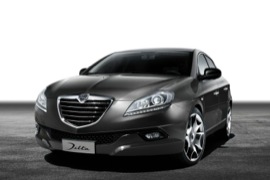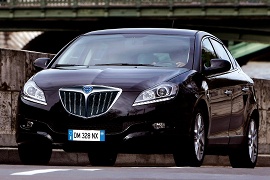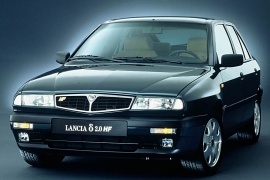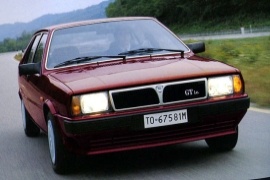LANCIA Delta Models/Series Timeline, Specifications & Photos
First production year: 1979
Engines: Gasoline, Diesel, Natural gas
Body style: Hatchback
Once a rally winner and a thrilling hatchback, the Delta adapted and became a more family-oriented vehicle and eventually died without any descendants in 2014.
Lancia lost its racing spirit when it introduced the third generation Delta in 2008. It even sold it as a Chrysler Delta on the U.K market, like it was ashamed to put the glorious Lancia badge on it. While its predecessor could tear the tarmac and grind the gravel under its all-wheel-drive traction system, the 2008 model was a humble front-wheel-drive, family-oriented hatchback.
There was nothing wrong with its styling. Italians were good on that. Its refreshed headlights sported an LED daytime running lights at the bottom and flanked the shield-like grille with horizontal slats and chromed surrounding. The aerodynamic-profiled wrapped-around bumper was similar to the one installed on the non-facelifted version but sported new fog lights.
Inside, the carmaker took care of its rear-seats passengers. Due to the unusually long wheelbase for a compact hatchback, it provided plenty of legroom. At the front, it offered the same amount of space as the Fiat Bravo since Lancia made the Delta based on that small-segment platform but with a longer distance between the front and rear axles. Since it was a family-oriented vehicle, the carmaker added a large trunk but with a high-loading lip. Too high to be ignored, and the carmaker didn't fix that on the facelifted version.
Under the hood, the carmaker installed a choice of two engines: 1.4-liter turbocharged gasoline or a 1.6-liter turbo-diesel. Lancia paired both of them to either a six-speed manual or a six-speed automatic. Power went to the front wheels only, and the car relied on McPherson struts at the front and trailing arms in the rear.
While the first generation of Lancia Delta had a huge number of fans, especially in the Delta Integrale version, the third generation was made for people who couldn't care less for the motorsport.
In the UK, the name Lancia Delta was so strongly tied with the rallying, that the Fiat-Chrysler Group decided to sell the vehicle as Chrysler Delta, instead of Lancia Delta. Despite its sports pedigree, the third generation of the Delta was a good alternative for the compact segment. It stood on the Fiat Bravo platform, but with a longer wheelbase.
From the outside, that looked like an elongated vehicle with big doors in the rear and a promise of a comfortable ride. The big shield-like grille on the front was chromed and the introduction of LED DRL was a fashionable upgrade. The car looked proper for a market where the customers were looking for compact hatchbacks with a big interior.
Inside, there was enough room for five passengers. The customers could have chosen from various trim levels and the top one was in the premium segment from the material quality point of view. In the rear, the seats could have been moved back and forth either to increase the legroom or the trunk.
The technical platform was not quite good for a premium vehicle or for a sporty one. It was fitted with front McPherson strut and rear semi-rigid type, but it featured an adaptive damping system.
While it carried a glorious name, the second generation of the Delta was just a regular compact hatchback that tried to make some money for Lancia.
Lancia considered that it gained all that it could from the previous Delta, and in 1993 it introduced a successor for the already 24 years old hatchback. The new generation got rid of its predecessor's wedged shapes and displayed rounded edges, narrower front fascia, and grille. On top of that, this time, Lancia offered the Delta in a three-door version as well. Unfortunately, the car was no longer meant for rallying.
The exterior featured slim, rectangular headlights with additional corner-mounted turn signals with clear lenses. The designers installed a flattened octagonal chromed rim around the black grille since the front area was narrow. Its flowing lines, with shaved edges, were far ahead of its predecessor, but they were too conservative for that era when everybody tried to make only soft edges and curved panels. In the rear, an up-kick raised the beltline to the C-pillar.
Inside, Lancia used the same interior as the one from the Dedra sedan lineup. Its instrument cluster was wide and extended over the center stack. Like its predecessor, it sported a comprehensive instrument cluster with more dials and gauges than a regular customer would need, including the oil temperature but not the pressure and an ammeter. Thanks to its wide-opening doors, the Delta offered easy access to its cabin, although it offered adequate room just for four occupants.
Under the skin, Lancia chose only front-wheel-drive solutions and a wide choice of engines that provided between 75 hp and 186 hp.
Designed as a contender in the compact segment, the Delta became one of the best-known cars ever made by Lancia and remained on the assembly lines until 1993.
The car was a common project between Saab and Lancia. It evolved from a humble vehicle to a rally star that won the World Rally Championship six times back to back. Rumors and information about the car surfaced in the spring of 1979, but the car was only officially unveiled at the Frankfurt Motor Show in September of that year. Suddenly, it became one of the main attractions of the event. Moreover, it won the much-coveted "European Car of The Year" award in December.
With a design signed by Giorgetto Giugiaro, the wedged-shaped Delta featured a flat front fascia with rectangular headlights. Its simple, plastic grille was split in the middle by a vertical slat that supported the carmaker's badge. On the profile, the car sported flat door panels, which were cheaper to build. Still, the designer created raked-forward C-pillars adorned with a few lines that gave the car a unique stance. It was available just as a five-door hatchback.
The wedged styling was continued inside with a slim dashboard and a rectangular, somewhat oversized instrument cluster that also included the center stack. That was unusual for those times. Its bucket seats at the front were not something special and reminded customers about those placed in the Fiat Ritmo. Lancia placed a flat-folding bench in the back for three, although the center tunnel that crossed the car made life difficult for the one seated in the middle.
Apart from the HF Integrale, the rest of the Delta range was powered by low-powered engines. However, after the car's debut, its success convinced the automaker to offer more potent engines and add an all-wheel drive system for specific versions.



